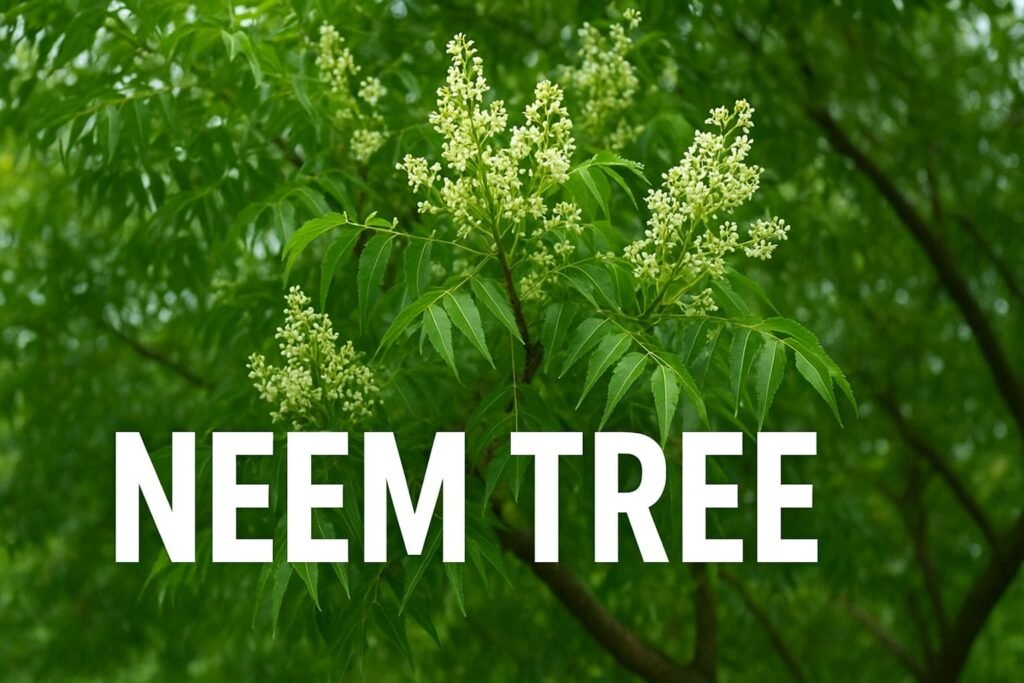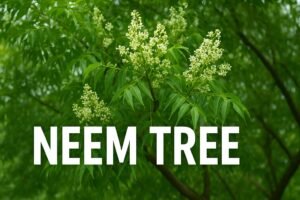The Neem tree (Azadirachta indica) is one of the most remarkable and beneficial trees found in India and many tropical countries around the world. Known as the “Village Pharmacy” or “Nature’s Gift to Mankind,” Neem is celebrated for its medicinal properties, environmental benefits, and cultural significance. At WildlifeNest.com, we bring you a deep dive into the fascinating life of the Neem tree — from seed to maturity, and beyond.
1. Scientific Classification of Neem Tree
| Attribute | Details |
|---|---|
| Common Name | Neem Tree |
| Scientific Name | Azadirachta indica |
| Family | Meliaceae (Mahogany family) |
| Native Range | Indian subcontinent |
| Type | Evergreen tree |
| Average Lifespan | 150–200 years |
| Average Height | 15–20 meters (can reach up to 35–40 meters in ideal conditions) |

2. Origin and Natural Habitat
The Neem tree is native to India, Nepal, Bangladesh, Pakistan, and Sri Lanka, but has been introduced to many tropical and subtropical regions worldwide due to its resilience and usefulness. It thrives in hot, arid, and semi-arid climates, tolerating poor soils, extreme heat, and minimal rainfall.
3. The Neem Tree Life Cycle – From Seed Dropping to Growth
A. Flowering and Seed Formation
- Neem trees start flowering after 3–5 years of planting.
- The flowers are small, white, and fragrant, attracting bees and other pollinators.
- Pollination results in the formation of small olive-shaped fruits.
B. Seed Dropping
- Fruits mature in 3–4 months after flowering.
- Ripe fruits turn yellowish-green and fall to the ground naturally.
- Animals such as birds, squirrels, and bats often feed on the fruits, aiding in natural seed dispersal.
C. Germination Process
- Fresh neem seeds have a high germination rate, but they must be sown within 2–3 weeks after harvesting because they lose viability quickly.
- Germination occurs 7–14 days after sowing.
- Seeds should be planted about 2–3 cm deep in moist soil.
- Direct sunlight is essential for healthy sprouting.
D. Sapling Growth
- The first year’s growth is relatively slow as the plant develops a strong root system.
- Neem has a deep taproot, which helps it survive droughts.
- By the second year, it grows faster, reaching 2–3 meters in height.
E. Maturity
- A Neem tree is considered mature after 10–15 years.
- Fully grown trees can yield up to 50 kg of fruit annually.
4. Physical Features of Neem Tree
- Leaves: Dark green, pinnate, with 20–30 leaflets.
- Bark: Rough, fissured, brownish-grey.
- Flowers: Small, white, fragrant, and in clusters.
- Fruit: Smooth drupe, yellow-green when ripe.
- Roots: Deep taproot with extensive lateral roots.
5. Environmental Benefits of Neem Tree
- Air Purification – Absorbs carbon dioxide and releases oxygen, improving air quality.
- Soil Improvement – Neem leaves and seed cake enrich the soil with organic matter.
- Shade and Shelter – Provides shade in hot climates and shelter for birds, bees, and insects.
- Erosion Control – Strong roots prevent soil erosion.
6. Medicinal and Practical Uses of Neem
A. Medicinal Uses
- Leaves: Used for skin conditions, fevers, and infections.
- Bark: Treats gum diseases and acts as a natural toothbrush (“datun”).
- Seeds & Oil: Used in cosmetics, insect repellents, and Ayurvedic medicines.
- Flowers: Beneficial in digestive disorders.
B. Agricultural Uses
- Neem oil is a natural pesticide against over 200 types of pests.
- Neem cake (residue after oil extraction) is used as an organic fertilizer.
C. Household Uses
- Neem twigs for brushing teeth.
- Neem leaves as a natural insect repellent in stored grains.
7. Role of Neem in Wildlife
Neem trees are not just useful to humans — they also support biodiversity:
- Birds use Neem branches for nesting.
- Bees collect nectar from its flowers.
- Insects feed on its leaves, although neem oil naturally repels most pests.
8. Cultural and Religious Importance
- In India, Neem is considered sacred and is associated with purity, health, and protection.
- During festivals like Gudi Padwa and Ugadi, people eat a paste made of Neem leaves for cleansing the body.
- In rural areas, Neem branches are hung at the entrance of houses to ward off evil spirits and diseases.
9. Interesting Facts about Neem Tree
- Neem is often called the “Tree of the 21st Century” by the United Nations for its sustainability.
- A fully grown Neem tree can live for over 200 years.
- Neem oil is one of the safest natural pesticides for organic farming.
- Its Latin name Azadirachta indica means “Free Tree of India”.
10. How to Grow Neem at Home
- Collect Fresh Seeds – Choose ripe yellow fruits, remove pulp, and use the seed immediately.
- Prepare Soil – Use well-drained sandy or loamy soil.
- Sowing Depth – Plant seeds 2–3 cm deep.
- Sunlight – Ensure at least 6–8 hours of direct sunlight daily.
- Watering – Water moderately; avoid waterlogging.
- Pruning – Light pruning after 1–2 years helps shape the tree.
11. Common Pests and Diseases
While Neem naturally resists many pests, it can be affected by:
- Powdery mildew
- Scale insects
- Root rot (due to overwatering)
12. Conservation and Plantation Efforts
Due to its eco-friendly benefits, many government and NGO programs promote Neem plantation across India. The tree’s ability to survive harsh conditions makes it a perfect choice for reforestation projects.
Frequently Asked Questions (FAQ) about Neem Tree
1. What is the scientific name of the Neem tree?
The scientific name of the Neem tree is Azadirachta indica. It belongs to the Mahogany family (Meliaceae) and is native to the Indian subcontinent.
2. How long does a Neem tree live?
A healthy Neem tree can live for 150 to 200 years or even longer under favorable conditions.
3. How tall can a Neem tree grow?
Neem trees usually grow between 15 to 20 meters, but in ideal conditions, they can reach 35–40 meters.
4. How do Neem trees grow from seeds?
Neem seeds should be sown fresh, within 2–3 weeks after harvesting, as they lose viability quickly. They germinate in 7–14 days when planted in moist soil with plenty of sunlight.
5. What are the uses of Neem leaves?
Neem leaves are widely used in traditional medicine for treating skin problems, fevers, and infections. They are also used as a natural insect repellent.
6. Is Neem oil safe for humans?
Neem oil is generally safe for external use but should not be consumed without medical advice. It is commonly used in cosmetics, hair care, and as a natural pesticide.
7. Can I grow a Neem tree at home?
Yes, Neem trees can be grown at home if you have enough space and sunlight. They prefer well-drained soil and at least 6–8 hours of sunlight daily.
8. When does a Neem tree start producing seeds?
Neem trees usually begin flowering and producing seeds after 3–5 years of growth.
9. Does Neem tree require a lot of water?
No, Neem trees are drought-tolerant and require only moderate watering. Overwatering can damage the roots.
10. Why is the Neem tree called the “Village Pharmacy”?
The Neem tree is known as the “Village Pharmacy” because almost every part of it — leaves, bark, seeds, flowers, and oil — has medicinal or practical uses for humans and animals.
Conclusion
The Neem tree is more than just a plant — it’s a symbol of health, sustainability, and resilience. From its humble seed dropping on dry soil to becoming a towering guardian of biodiversity, Neem continues to serve humans, animals, and the planet. At WildlifeNest.com, we celebrate such natural treasures that quietly work for the betterment of all life.
The Unsung Heroes of Wildlife Habitats
Types of Grass – A Complete Guide
Butterfly Parks in India – A Colorful World of Wings
World Snake Day: Celebrating the Silent Guardians of Our Ecosystem


